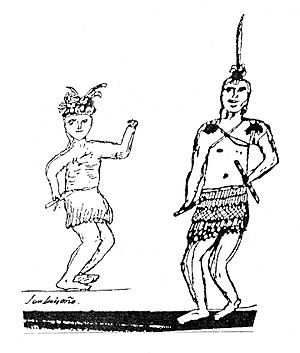Pablo Tac facts for kids
Quick facts for kids
Pablo Tac
|
|
|---|---|
| Born | 1822 |
| Died | 1841 (aged 19) |
| Nationality | Luiseño |
| Education | College of the Propaganda |
| Known for | Illustration, writing, scholar |
Pablo Tac (born 1822, died 1841) was a young Luiseño (Quechnajuichom) Indian from California. He was a very smart scholar who gave us a rare look into the lives of Native Americans in Alta California a long time ago. He even created the first way to write the Luiseño language. His writings are super important because they are the only main source about the Luiseño language written by a Luiseño person until the 1900s!
A Young Life of Learning
Pablo Tac was born to Luiseño parents at Mission San Luis Rey de Francia in what is now Oceanside, California. He went to school at the Mission. He was such a bright student that a Franciscan missionary, Father Antonio Peyrí, chose him and another boy to travel with him.
In 1832, Father Peyrí left California. Pablo and the other boy went with him. They traveled through Mexico City, then sailed to Europe. They even stopped in New York and France before arriving in Barcelona, Spain, in June 1834. This was a huge journey from the "New World" to the "Old World"!
In September 1834, Pablo arrived in Rome, Italy. He joined the College of the Propaganda, a special school. There, he studied Latin grammar, then moved on to rhetoric, humanities, and philosophy. He was preparing to become a missionary. Sadly, Pablo Tac passed away in 1841 when he was only 19 years old.
Pablo Tac's Important Writings
Even though he lived a short life, Pablo Tac created amazing works. As a student, he wrote a grammar and dictionary for the Luiseño language. He made it for a linguist named Giuseppi Mezzofanti. What's special is that he also included a history of his people in his writings. He found a way to write Luiseño using ideas from Latin and Spanish. This way of writing is different from how Luiseño is written today.
Pablo also wrote an essay called "Conversion of the San Luiseños of Alta California." This essay shares details about the traditional ways of life for his people. It talks about their dances and games. It also describes the history and how the Mission was set up. He even included two of his own drawings in it!
He also wrote a book called Indian Life and Customs at Mission San Luis Rey. It was written around 1835. In this book, Pablo shared his sadness about how his people were disappearing. He wrote:
In Quechla (the Luiseño homeland) not long ago there were 5,000 people. Then a sickness came to California, and 2,000 people died. Only 3,000 were left.
Pablo also described how the Spanish priests, called padres, lived very well at the Mission:
At the Mission of San Luis Rey de Francia, the Fernandino father is like a king. He has his helpers, leaders, managers, musicians, soldiers, gardens, ranches, and animals...
He also wrote about how his people first tried to stop the Spanish from coming into their lands in Southern California. When the foreign visitors arrived, he said:
...the chief stood up...and met them, asking, ...what are you looking for? Leave our country!
Remembering Pablo Tac
Many people remember and honor Pablo Tac today:
- In 2005, a Luiseño artist named James Luna created an artwork for the Venice Biennale to honor Pablo Tac. The artwork was called Emendatio. It included different art pieces and a performance.
- On June 7, 2012, a hall at Mission San Luis Rey was named in honor of Pablo Tac.
- In July 2019, an author named Christian Clifford gave a workshop about Pablo Tac in Ohio.
- In June 2021, the Oceanside Unified School District Board of Education decided to rename two combined elementary schools after Pablo Tac. This means there is now a Pablo Tac Elementary School!


